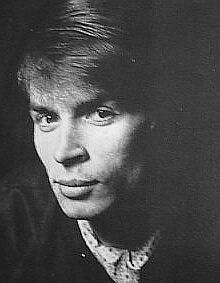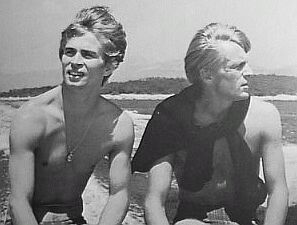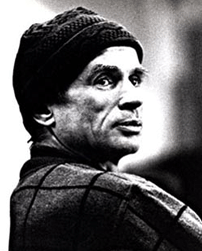Rudolf Nureyev
|
|
Rudolf Khametovich Nureyev (Russian spelling Рудольф Хаметович Нуреев, Tatar form Rudolf Xämät ulı Nuriev) (17 March 1938 – 6 January 1993), Russian-born dancer, was regarded by many critics as the greatest male dancer of the 20th century, alongside Vaslav Nijinsky and Mikhail Baryshnikov. He was born in a train near Irkutsk, while his mother was travelling across Siberia to Vladivostok, where his father, a Red Army political commissar of Tatar descent, was stationed. He was raised in a village near Ufa in Soviet Bashkiria. As a child he was encouraged to dance in Bashkir folk performances and his precocity was soon noticed.
Due to the disruption of Soviet cultural life caused by World War II, Nureyev was unable to enroll in a major ballet school until 1955, when he was sent to the Vaganova Choreographic Institute, attached to the Kirov Ballet in Leningrad. Despite his late start, he was soon recognised as the most gifted dancer the school had seen for many years. Already, however, his extremely difficult temperament was evident. In retrospect it seems obvious that his personal problems were mainly due to internal conflict over his sexuality.
Within two years Nureyev was one of Russia's best-known dancers, in a country which revered the ballet and made national heroes of its stars. Soon he enjoyed the rare privilege of travel outside the Soviet Union, when he danced in Vienna at the International Youth Festival. Not long after, for disciplinary reasons, he was told he would not be allowed to go abroad again. He was condemned to tours of the Russian provinces.
In 1961 Nureyev's luck turned. The Kirov's leading male dancer, Konstantin Sergeyev, was injured, and at the last minute Nureyev was chosen to replace him in a performance in Paris. In Paris, his performances electrified audiences and critics. But Nureyev broke the rules about mingling with foreigners, and was told he would be sent home. Realising he would probably not be allowed abroad again, on 17 June at Charles De Gaulle International Airport, he defected. He did not see Russia again until 1989, when he visited at the special invitation of Mikhail Gorbachev.
Within a week Nureyev had been signed up by the Grand Ballet du Marquis de Cuevas and was performing The Sleeping Beauty with Nina Vyroubova. Nureyev was an instant celebrity in the west. His dramatic defection, his outstanding skills, and, it must be said, his astonishing good looks, made him an international star. This gave him the power to decide where and with whom he would dance.
Nureyev's defection also gave him the personal freedom he had been denied in the Soviet Union. On a tour of Denmark he met Erik Bruhn, another dancer ten years his senior, who became his lover, his closest friend and his protector (mainly from his own folly) for many years. The relationship was a stormy one, for Nureyev was highly sexually promiscuous, but in its own way a very strong one. Bruhn was director of the Royal Swedish Ballet from 1967 to 1972 and Artistic Director of the National Ballet of Canada from 1983 until his death in 1986. One of the men that Nureyev is said to have had an affair with was movie star Anthony Perkins.
At the same time Nureyev met Margot Fonteyn, the leader British dancer of her time, with whom he formed a professional partnership and a close friendship. She brought him to the Royal Ballet in London, which remained his base during the rest of his dancing career. Together Nureyev and Fonteyn transformed cornerstone ballets as Swan Lake and Giselle.
Nureyev was immediately in demand by film-makers, and in 1962 he made his screen debut in a film version of Les Sylphides. In 1976 he played Rudolph Valentino in Ken Russell's film, but he had neither the talent nor the temperament for a serious acting career. He branched into modern dance with the Dutch National Ballet in 1968. In 1972 Robert Helpmann invited him to tour Australia with his own production of Don Quixote, his directorial debut.
During the 1970s, Nureyev appeared in several movies and toured the United States in a revival of the Broadway musical The King and I. His guest appearance on the then struggling television series, The Muppet Show is credited for boosting the series to worldwide success. In 1983 he was appointed director of the Paris Opera Ballet, where as well as directing he continued to dance, and to promote younger dancers. Despite advancing illness towards the end of his tenure, he worked tirelessly, staging new versions of old standbys and commissioning some of the most groundbreaking choreographic works of his time.
Nureyev's talent, beauty and charm caused him to be forgiven many things, but stardom did little to improve his temperament. He was notoriously impulsive, moody, unreliable, and rude to those he worked with. He mixed with Jacqueline Kennedy Onassis, Mick Jagger and Andy Warhol, and had little time for non-celebrities. By the end of the 1970s, as he moved into his 40s and became aware of the inevitable decline of his amazing physical prowess, these character flaws became more noticeable, and more noted.
When AIDS appeared in France in about 1982, Nureyev, like many French gay men, took little notice. He presumably contracted HIV at some point in the early 1980s. For several years he simply denied that anything was wrong with his health: when, in about 1990, he became undeniably ill, he pretended he had several other ailments. He refused whatever treatments were available at that time.
Eventually, however, he had to face the fact that he was dying. He won back the admiration of many of his detractors by his courage during this period. The loss of his looks pained him, but he continued to struggle through public appearances. At his last appearance, at a 1992 production of The Bayadère at the Palais Garnier, Nureyev received an emotional standing ovation from the audience. The French Culture Minister, Jack Lang, presented him with France's highest cultural award, the Chevalier de l'Ordre des Artes et Lettres. He died in Paris, France ,a few months later, aged 54.
Further reading
- Diane Solway, Nureyev: His Life, William Morrow & Co, 1998
External link
- Birthday tribute (http://www.culturekiosque.com/dance/Features/rhebaya.htm)
Nureyev was also the name of a famous American racehorse (1977-2001)
de:Rudolf Chametowitsch Nurejew es:Rudolf Nureyev it:Rudolf Nureyev ja:ルドルフ・ヌレエフ tt:Rudolf Nuriev



